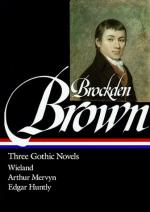|
This section contains 14,020 words (approx. 47 pages at 300 words per page) |

|
SOURCE: "Ambiguous Evil: A Study of Villains and Heroes in Charles Brockden Brown's Major Novels," in Early American Literature, Vol. X, No. 2, Fall, 1975, pp. 190–219.
In the following essay, Cleman studies the main characters in Brown 's major novels and argues that their interrelationships demonstrate that the ambiguity in Brown 's work was purposeful and carefully constructed.
In the first issue of his Weekly Magazine Charles Brockden Brown wrote, "Great energy employed in the promotion of vicious purposes, constitutes a very useful spectacle. Give me a tale of lofty crimes, rather than of honest folly."1 Such morbid intentions were certainly carried out, for in his major works—Wieland (1798), Ormond (1799), Arthur Mervyn (1799, 1800), and Edgar Huntly (1799)—Brown created a remarkable array of villains and "lofty crimes."2 For some time, the usual treatment of these characters was to see them as simply conventional figures embodying certain ideas to be tested in the...
|
This section contains 14,020 words (approx. 47 pages at 300 words per page) |

|


